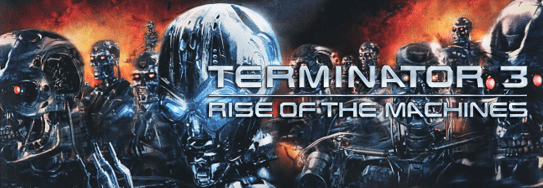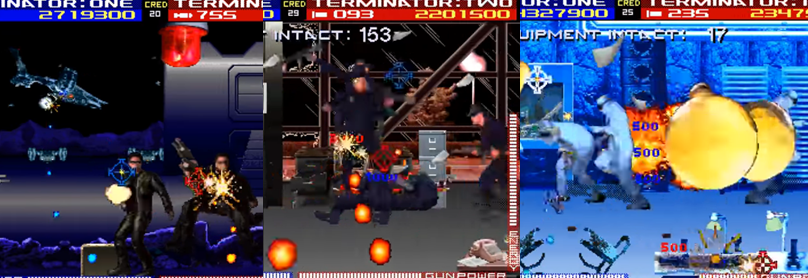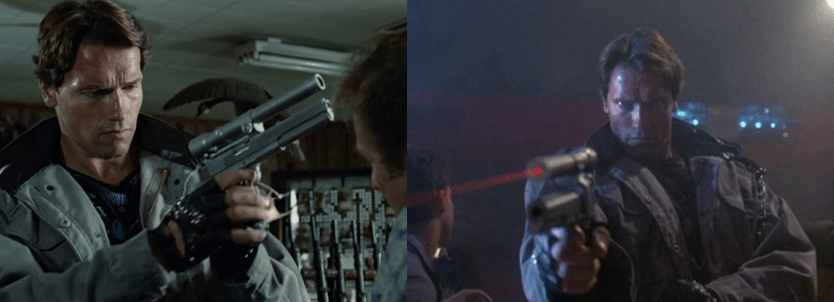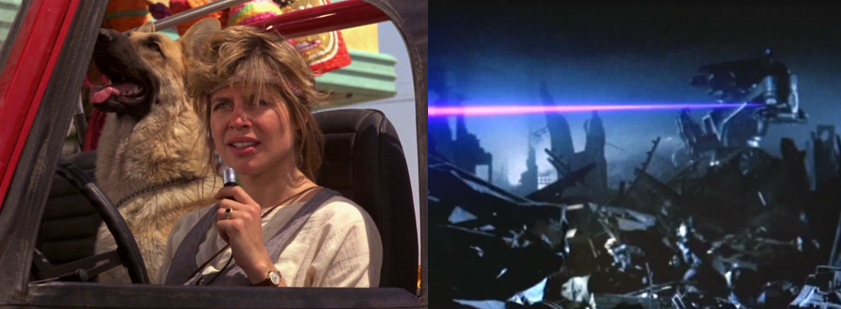“Three billion human lives ended on August 29th, 1997. The survivors of the nuclear fire called the war Judgment Day. They lived only to face a new nightmare: the war against the machines”.
Yes, friends, today’s the day that Skynet, the malevolent artificial intelligence of the Terminator franchise (Various, 1984 to 2019), was said to have launched an all-out nuclear attack against humanity and reduced us to the point of extinction. Subsequent Terminator films and media may have changed this date, and the specifics of Judgement Day, but one thing’s for sure: there is no fate but what we make for ourselves.
Released: 2 July 2003
Director: Jonathan Mostow
Distributor: Warner Bros. Pictures / Columbia TriStar Film Distributors International
Budget: $187.3 million
Stars: Arnold Schwarzenegger, Nick Stahl, Claire Danes, Kristanna Loken, and David Andrews
The Plot:
Years after ensuring that the malevolent artificial intelligence known as Skynet doesn’t come into creation, John Connor (Stahl) is haunted by dreams of an apocalyptic future. His fears come to life when an all-new Terminator, the T-X/Terminatrix (Loken), travels through time to murder prominent members of the future Resistance. John’s only hope is a reprogrammed T-850 machine (Schwarzenegger) that has been sent not only to protect him…but also his future wife!
The Background:
Since The Terminator (Cameron, 1984) was an unexpected financial success, there was little doubt that a sequel would soon follow. Terminator 2: Judgment Day (ibid, 1991) not only out-did its predecessor at the box office but is frequently regarded as one of the greatest movie sequels ever made. Although the man behind the franchise, James Cameron, and his co-writer were adamant that T2 marked the natural end for the story, producer Gale Anne Hurd and Carolco Pictures both pushed for a third film, and Cameron became involved after working on the theme park ride T2-3D: Battle Across Time. After Carolco filed for bankruptcy, 20th Century Fox negotiated with the stars and filmmakers to try and get the project off the ground, but financial concerns soon saw the rights fall into the hands of Andrew G. Vajna and Cameron eventually giving his blessing for a third film to be made without his involvement after repeated attempts and missed opportunities to purchase the rights for himself. Although initially reluctant to return to the franchise without Cameron, Schwarzenegger was advised by the director to reprise his role for the money, if nothing else, a decision which ultimately led not only to his staggering $30 million salary but also him putting up $1.4 million of his own money to complete an elaborate chase scene.
Schwarzenegger worked daily to get back into peak shape for his most iconic role, and even had a gym on set to work out in; however, he returned without co-star Linda Hamilton, who declined reprising her role as Sarah Connor due to being unimpressed with the script. Although Edward Furlong initially signed on to return as John Connor, his substance abuse problems led to him being replaced with Nick Stahl, a decision which alienated some fans. Kristanna Loken beat out the likes of Famke Janssen and Vin Diesel for the T-X role, who was once again brought to life by the legendary Stan Winston and Industrial Light & Magic, who used a combination of miniatures, practical, and visual effects brought the new semi-liquid metal Terminator to life. Although Terminator 3: Rise of the Machines impressed with a $433.4 million box office, reviews were dissatisfied with the film’s mindlessness and redundant narrative. Terminator 3’s derivative nature and tone-deaf humour marked it as a low point for the franchise, rather than a return to form; even a couple of tie-in videogames and Schwarzenegger’s return to his most famous role failed to impress, and it wouldn’t be long before the franchise rights were once again shopped around to a new owner.
The Review:
Personally, as much as I love the Terminator films, I never actually found myself clamouring for a third entry. At least, not one that continued the story past the second film, anyway. I always thought there was potential in a prequel, though, one set during the Future War and showing John Connor’s struggles against the machines. I’ve always felt that it was a missed opportunity that we never got to see this sweeping shot of an army of Arnolds marching over a skull-littered, post-apocalyptic wasteland firing lasers at hapless Resistance fighters. On the other hand, I was mildly excited for Terminator 3 simply because it would be the first time I’d get to see a Terminator movie at the cinema, and the trailers had done a relatively decent job of selling the film as an action-packed spectacle, but this would be the start of a downward spiral for the franchise in which far too many sequels and spin-offs sought to ape the franchise-changing success of Terminator 2 rather than actually try something new.
Having narrowly escaped with this life after the events of the second film, John Connor is all grown up and has inherited his mother’s paranoid and nightmarish visions of a war-torn future. In the years between Terminator 2 and Terminator 3, Sarah Connor (Linda Hamilton) has died of leukaemia, but had managed to stay alive (against all medical logic) just long enough to ensure that the world didn’t end on August 29th, 1997 as Kyle Reese (Michael Biehn) had once warned. The world continued on as always, but John was forever traumatised by her loss and his knowledge of a world overrun by killer machines, so he took himself off the grid and went on the run, drifting from place to place and job to job before, conveniently, ending right back where he started in California. So distracted by his nightmares is John that he takes a nasty fall from his bike and is forced to break into a veterinarian’s to patch himself up, and in the process coincidentally runs across an old flame of his, Katherine Brewster (Danes), who he’d once made out with as a kid. John’s reputation proceeds him, however, as Kate remembers his foster parents dying and him disappearing under suspicious circumstances, but he’s forced to reveal the truth about himself, and what happened all those years ago, when they’re attacked by the T-X and saved by the Terminator. Like Sarah before him, John is stunned to see the familiar, grim-faced cyborg return; so stunned, in fact, that he inexplicably believes the machine to not just be the same make and model as the last Terminator but to literally be his former father figure, which I guess you can chalk up to the shock of learning that their efforts to stop Skynet’s creation and the onset of Judgement Day simply delayed the inevitable. I never quite “got” the Nick Stahl experiment; he popped up in a few films around this time and he just never really clicked for me. He plays John as a neurotic, quirky, and melancholic drifter, one who feels beaten down by the expectation placed upon him by his mother’s teachings (and, apparently, fate) since he feels ill-equipped to be the future saviour of mankind. Thus, John does everything he possibly can to once again rally against this desolate future; his focus remains not on surviving the oncoming nuclear apocalypse, as the Terminator emphasises, but on stopping it altogether by infiltrating the source of Skynet’s creation, now shifted to Cyber Research Systems (CRS), and his entire character seems to be in this limbo between abject denial of the obvious truth staring him in the face and a resigned acceptance that the world expects more than he is prepared to give.
New to the lore is the idea that, in the future, John will have a wife and child; thanks to the events of Terminator 2, the timeline has shifted, delaying Judgement Day and altering the future somewhat, to the point where the future Kate ends up being the one who sends the reprogrammed Terminator back through time to act as John’s protector once more. In the present day, however, Kate is little more than a naïve and under-appreciated vet; her priorities involve little more than registering gifts for her wedding to kindly, one-dimensional milksop Scott Mason (Mark Famiglietti), tending to the animals under her care, and trying to build bridges between Scott and her overprotective father, Lieutenant General Robert Brewster (Andrews). Kate acts as the audience surrogate here and, though there’s a brief suggestion that she’s not entirely sure about her upcoming wedding, her simple life is turned upside down in the most violent way possible when the cyborg killers literally come crashing into her vet in search for her. While she’s confused and overwhelmed, Kate is a pretty feisty character; she tricks John and stuns him with a taser, locking him up in a cage until she can figure out what’s going on, and even tries (futilely) to fend off the Terminator when it manhandles her for her own safety. Believing herself to be the victim of an elaborate kidnapping, Kate is sceptical of John’s claims about the future and the machines and escapes at the first opportunity, only to witness Scott transform into the T-X before her eyes and be faced with the undeniable truth that Skynet is a very real, very much impending threat. Kate barely even mourns Scott, however, and instead focuses on safeguarding her father from the T-X and using his connection to CRS to help them locate the Skynet mainframe. In the process, she undergoes a transformation not a million miles away from Sarah’s in the first film (John even remarks that she “reminds [him] of [his] mother”) that shows a glimpse of how proactive and capable she can be under stressful situations. Though she is adamant (nay, disgusted) that she and John will never be a couple in the future, she’s the first of the two to piece together that their mission wasn’t to prevent Judgement Day, but to survive it, and accepts their fate much faster than John in the finale. Kate brings an interesting perspective on the Terminator, one similar to John’s in the second film, as she addresses it as though it’s a person rather than a machine, and, through her curiosity, we learn that the Terminator might not be capable of human emotions but seems nevertheless despondent at the idea of failing its mission, which John later uses to snap it out of the T-X’s corrupting nanites.

While Arnold naturally slips back into his most famous role looking like barely a year has past since his last appearance, the Terminator once again undergoes a transformation for its third outing; although it still has a fancy for leather jackets, sunglasses, and stoic quips like its predecessor (and even has recognisable traits like checking for car keys under the sun visor and ensuring it doesn’t kill), the titular Terminator is, naturally, a completely different machine than before. Hell, it’s actually a different model entirely, being a T-850 rather than a T-800, which actually translates to a few notable additions and alterations, but it’s made explicitly clear that this once fearsome unstoppable killer and heroic father-figure is now a figure of comedy as, rather than ripping apart street punks or tossing aside a bar full of bikers to get its threads, this Terminator wanders into ladies’ night and accosts a male stripper. Additionally, this Terminator is powered by two highly combustible hydrogen fuel cells, making it functionally more vulnerable than its predecessors, and second is its programming in basic human psychology. This allows the Terminator to lie, cross-examine, and offer insight into the mental welfare of its charges (though it admits that its database “does not encompass the dynamics of human peer bonding”), and is largely used to comedic effect as the Terminator awkwardly encourages the two to mate, gets offended at being labelled a “robot”, and barks commands to the hysterical Kate in an effort to calm her down. One scene where this really comes into play is when John, overwhelmed at the burden he’s been forced to carry since he was a child, has a complete breakdown in his mother’s tomb and the Terminator calls his bluff, threatening to choke the hysterical John until he spits vitriol in the Terminator’s face since “Anger is more useful than despair”. This means that, while this Terminator is absolutely a protector figure, it’s far more blunt and less patient with the human protagonists (especially John, who is in real need of a kick up the ass that the Terminator is happy to provide) and concerned only with safeguarding them to meet their destiny. Another difference that is really underplayed is the fact that this Terminator wasn’t chosen at random; it infiltrated the Resistance and utilised Future-John’s emotional connection to its model number to terminate him. It was then reprogrammed by Future-Kate and sent back to protect him, meaning that John is faced not just with the inevitability of his eventual death but also forced to rely on the machine that will one day kill him, and the Terminator consequently only follows Kate’s orders. Again, this is largely played for comedic effect but there was some real potential behind this concept, and the Terminator even seems to deliver John a warning in the finale (“We will meet again”) to perhaps enable him to avoid his fate.

As outclassed as the Terminator was in Terminator 2, there’s no question that it’s on the backfoot this time around; the Terminator even admits that it’s an “obsolete design” compared to the Terminatrix, an apathetic and alluring cyborg assassin that has both a metal endoskeleton and a liquid metal exterior. Somehow, this allows the T-X to shape-shift like its predecessor (I guess the endoskeleton is liquid metal, too…which only raises more questions about how it survived the trip through time…) but the T-X rarely uses this ability; instead, it relies on its ability to transform its arms into weapons. And not “knives and stabbing weapons” like the T-1000 (Robert Patrick); this bitch creates an energy cannon and a flamethrower, though, again, this ability is rarely utilised. The T-X seems to be on a tight deadline here as there’s no question at all that it’s the villain of the film since we see it tracking down and murdering John’s future lieutenants (who are young kids, no less) in cold blood rather than make any attempt at subterfuge. The T-X has other new abilities as well; it can grow its breasts to distract men, identify humans by sampling their blood, and is able to infect and remotely control computer systems and machines using a kind of nanotechnology. This allows it to chase after its prey by controlling police cruisers (which is pretty inconceivable since there’s no way they’d be able to drive in the way she controls them), taking over the T-1 machines at CRS, and even corrupts the Terminator’s systems to set it against John and Kate. The T-X is every bit as formidable as the Terminator, easily overpowering it and taking its shots in their brawl, but is portrayed as being both faster and more powerful in every conceivable way, which contributes to the Terminator’s primary plan of escaping to safety rather than trying to tackle it head-on. The T-X isn’t entirely vulnerable, though; rocket launchers soon damage its arm and it’s rendered temporarily helpless thanks to the magnetic pull of a particle accelerator, but it’s a pretty vicious and vindictive machine; it not only hunts down and murders John’s future allies in cold blood, but shoves its hand through a police offer’s stomach in the film’s bloodiest sequence. I know Kristanna Loken from the under-rated Mortal Kombat: Conquest (1998 to 1999) and this basically remains her biggest film role to date; she does a decent job of portraying an emotionless killer cyborg but, like the Terminator and T-1000 before her, also adds a lot of nuance to the role. The T-X becomes visibly frustrated at the Terminator’s interference and screams with rage, scurrying about like an insect as it desperately tries to fulfil its mission in the finale.
The Nitty-Gritty:
If you’ve seen Terminator 2, then you’ve basically seen everything Terminator 3 has to offer. The film borrows so much from its predecessor that it’s not even funny, which is super ironic considering the film offers a more comedic slant on moments such as the Terminator acquiring its clothing (now from a male stripper who doesn’t seem to match Arnold’s dimensions in the lightest), exhibiting personality and humanity, and even offering neutered versions of actions sequences like the assault on Cyberdyne and CRS, respectively. Consequently, many of the same themes from the second (and first) film carry over here; there’s a focus on fate and destiny, the inevitability of our own destruction, and the dangers of artificial intelligence, but the fundamental message of the Terminator franchise has been twisted simply to justify the existence of this film. Previously, the message was “The future’s not set. There’s no fate but what we make for ourselves” but it turns out that this was a bit of a misdirect; Judgement Day is now seen as “inevitable”, the creation of a destructive A.I. unavoidable, and it no longer matter show hard the characters fight or deny this fact, humanity is doomed to be driven to the point of complete destruction. This means that Terminator 3 has a far bleaker tone than the last film, which ended on a message of hope, and instead skews the narrative into one where it’s somewhat implied that everything that’s happened (including the future messages) has been to get John born, trained, and to safety so he can lead humanity to ultimate victory rather than trying to avoid this outcome altogether.
Although Sarah is dead, her presence is very much felt throughout the film; one of the many demons John is trying to hide from is the teachings and expectations she placed upon him and, while he loved his mother and clearly misses her, he also resents her for tainting his childhood and screwing him up with stories of war against the machines. Although she held on to ensure that Judgement Day didn’t happen, it turns out that Sarah was also unable to shake off her fear and paranoia and had a casket full of armaments buried in place of her remains, which helpfully enables one of the film’s more visually interesting shoot-outs. Earl Boen makes a surprising and amusing return for his cameo as Doctor Peter Silberman, which sees him offering some mild comfort to Kate and then fleeing in fear at spotting the Terminator, and there are so many mentions of Terminator 2 that it’s genuinely hard for the film to stand on its own two feet. Interestingly, and disappointingly, Terminator 3 fails to borrow the iconic Terminator theme until the end credits; Marco Beltrami’s score is suitably machine-like and has traces of Brad Fiedel’s memorable work laced throughout it, but it’s just not Terminator without the “duh-duh-dun-duh-dun” at the forefront of the soundtrack. And yet, Robert Brewster heads up CRS, which acquired Cyberdyne’s assets and is in the midst of struggling with a particularly aggressive computer virus throughout the film. Although his technicians insist that Skynet will be able to identify and eradicate the virus, Brewster is reluctant to activate the advanced artificial intelligence as he’s uncomfortable with handing over that much power and responsibility to a machine. Unfortunately, he’s over-ruled by his superiors and John and Kate are unable to get there in time to stop him from bringing Skynet online; he realises all too late that Skynet was the virus and that he has effectively doomed humanity to near extinction from the self-aware A.I. Gunned down by the T-X, Brewster pleads with John to get Kate to safety and provides them with the location of Crystal Peak, and their last hope at stopping the nuclear apocalypse.
Visually, Terminator 3 is still pretty impressive; the opening rendition of the Future War, in which we see an army of Terminator endoskeletons carving a path of destruction across a smouldering battlefield, are as harrowing as those of the previous films. Additionally, this is the first time we actually see the Terminators arrive in the past in full detail, which was cool as I’d always wondered about how they actually materialised in the past. Although the effects have definitely moved more towards CGI than practical puppetry and animatronics, traditional effects remain a constant highlight. Not only does the Terminator cut open its abdomen to remove its damaged fuel cell, but the T-X’s armaments (no pun intended…) are largely practical, and there’s some pretty enjoyable throwdowns between the two machines once they swap out their weapons for hand-to-hand combat. However, the appeal of these fights is, again, more comedic than tense; the T-X grabs the Terminator’s crotch, the two smash each other into toilets, and the main thrust of their combat is based around the once terrifying cyborg killer being manhandled (or, I guess, machinehandled?) by a smaller, female variant against which it has very little chance of success. While the big chase scene is pretty thrilling and involves a lot of destruction, it’s hard to not spot the overabundance of CGI used to flip cars and send the Terminator crashing through walls. Similarly, it’s a bit of an awkward effect when the Terminator reattaches its severed head, though the CGI does allow for probably the best battle-damaged look for the Terminator in the finale. Additionally, the T-1 machines are entirely practical, which makes for some fun (and deceptively impactful) scenes of them trundling around CRS and gunning down technicians like hulking Grim Reapers, and the effects used to bring the Future War to life are better than ever, but a lot of the gritty, weighty, mechanical feel of the previous films is lost in favour of a sleek shine that gives the Hunter Killers (HKs) and the T-X’s endoskeleton a glossy, almost alien aesthetic but also makes them feel very fake. Say what you will about the jerky puppets and stop-motion effects of the first film but I never felt like the Terminator wasn’t “there” in the scene but, here, fights and sequences often boil down to CGI ragdolls flailing about like action figures, which somewhat undermines any dramatic tension we’re supposed to feel.
In fact, dramatic tension is difficult to find anywhere in Terminator 3 because the awkward focus on making jokes, quips, and gags even when the characters are fleeing for their lives or discussing the extinction of humanity. The Terminator throws up a “Talk to dah hand”, which severely dates the film, casually mentions how it assassinated John, and much of its delivery is meant to illicit a chuckle from the audience, which really creates a very tone-deaf film. Moments of levity were few and far between in the last two films, but when they popped up they were natural and didn’t feel anywhere near as forced; when the Terminator snapped “Fuck you, asshole”, it was an amusing glimpse at how human the killer cyborg could be, and the T-1000’s “Say…that’s a nice bike” had an air of menace to it that was only exacerbated by how callously it murdered people previously. Here, the Terminator is going out of its way to shop for designer sunglasses, roughly grabbing John and Kate to assess their physical wellbeing, and spitting out bullets and admonishing Kate all for a cheap laugh and it’s jarring not just for the franchise but in the context of the film. As soon as the Terminator acquires John and Kate, it tries to get them to safety so they can survive the inevitable blast zones, but is constantly derailed from its mission by John and Kate’s insistence that they try to stop the war. Despite continuously emphasising that the war can’t be stopped since there’s no time and they’ve no hope of fighting the T-X, the Terminator is duty-bound to go along with their commands, but John is distraught to find that Crystal Peak doesn’t contain Skynet’s system core but a fallout shelter for governmental officials. The Terminator (literally) crashes in to battle the T-X one last time, ultimately sacrificing itself by jamming its remaining fuel cell into the T-X’s mouth and ending its threat, leaving John with the stark realisation that the future he has long feared and rallied against is finally coming to pass. In a poignant moment that the film in no way earns, the bombs drop as John and Kate embrace in the bunker, begrudgingly left with no choice but to prepare for the fight of their lives, and ending the film on a depressingly bleak note that is decidedly at odds with the majority of its more comedic runtime.
The Summary:
It’s hard to deny that Terminator 3: Rise of the Machines was a massive misfire; rather than trying to do something fresh and new with the franchise, the film settled on being a poor man’s rip-off of Terminator 2, something that would unfortunately continue to plague the series going forward. I get it, I honestly do; if you’ve bought the rights to the Terminator films, you want Arnold back and you want to try and recreate what worked before, but there were so many other avenues that the filmmakers could’ve gone down here. The idea of Skynet hunting down John’s lieutenants has a lot of potential, and could have been the focal point of the film; maybe John could’ve taken on the Kyle Reese role to protect Kate from the Terminator, which would not only draw a bit more from the first film but also allow Arnold the chance to do something a little different by portraying a evil version of his most iconic character once more. Or, even better, do the Future War and show the Resistance fighters battling the machines, which was probably beyond the budget of this movie, but the end result was got is a conflicting, confusing mess of a film that isn’t sure if it wants to be a family friendly action comedy or a dour science-fiction movie laying the foundation for a devastating apocalypse. The tone and atmosphere is all over the place, completely negating any of the high points (and there are some, like the car chase, the Terminator-on-Terminator fight scenes, and the dour ending) and leaving a sour taste in the mouth since it literally feels like we just watched a budget version of Terminator 2. It’s no surprise that, when viewing the timeline of the Terminator movies, it’s pretty easy to skip this one; while Kate does eventually make a return, pretty much every Terminator production after this just ignored this one and I can’t say that I blame them as it’s a pretty disappointing and unnecessary retread of ground we’d seen done bigger and better back in 1991.
My Rating:
Could Be Better
By any chance, did you enjoy Terminator 3: Rise of the Machines? How do you think it compares to the first two films and the other sequels? Were you a fan of Arnold Schwarzenegger’s performance and the changes made to his character? What did you think to Terminatrix and its abilities? Were you a fan of Nick Stahl’s take on John Connor and what did you think to his relationship with Kate? Did you enjoy the greater emphasis on CGI this time around? How are you celebrating Judgement Day today? No matter what you think about Terminator 3, and the Terminator franchise, feel free to s leave a reply down below or drop a comment on my social media.





























































































You must be logged in to post a comment.